
SUMMARY REPORT
HIGH SCHOOL RIO
TM
(REPORTING INFORMATION ONLINE):
INTERNET-BASED SURVEILLANCE OF INJURIES SUSTAINED BY
US HIGH SCHOOL ATHLETES
2005-2006
Compiled by:
R. Dawn Comstock, PhD
Ellen E. Yard, MPH
Christy L. Knox, MA
Jennifer Manring, BA
Acknowledgements
We thank the certified athletic trainers (ATCs) for their hard work and dedication in providing us
with complete and accurate data. Without their efforts, this study would not have been possible.
We would like to thank the National Federation of State High School Associations (NFHS) for
their support of this project. We would also like to thank individuals who consulted on this
project, Jon Almquist, National Athletic Trainers’ Association (NATA); Randy Dick, National
Collegiate Athletic Association (NCAA); Jerry Diehl, NFHS (retired); Fred Mueller, National
Center for Catastrophic Sport Injury Research (NCCSI); Art McDonald, US Consumer Product
Safety Commission (CPSC) (retired). This report was funded by the Centers for Disease Control
and Prevention (CDC) grant #R49/CE000674-01. The content of this report is solely the
responsibility of the authors and does not necessarily reflect the official view of the CDC.
Note
The analyses presented here provide only a brief summary of collected data, with the feasibility
of a more-detailed presentation limited by the extensive breadth and detail contained in the
dataset. The principal investigator, Dr. R. Dawn Comstock, is happy to provide further
information or to discuss research partnership opportunities upon request.
For reprints/further information contact:
R. Dawn Comstock, PhD
Columbus Children’s Research Institute
700 Children’s Drive
Columbus, OH 43205
(614) 722-2400
[email protected]io-state.edu
2
Chapter Contents Page
1. Introduction and Background 5
1.1 Project Overview 5
1.2 Background and Significance 5
1.3 Specific Aims 6
1.4 Project Design 7
1.4.1 Sample Recruitment 7
1.4.2 Data Collection 8
1.4.3 Data Management 8
1.4.4 Data Analysis 9
2. Rates of Injury 10
3. General Injury Epidemiology 12
3.1 General Injury Patterns 12
3.2 Additional General Injury Information 22
4. Sport-Specific Injury Epidemiology 23
4.1 Boys’ Football 23
4.2 Boys’ Soccer 26
4.3 Girls’ Soccer 29
4.4 Girls’ Volleyball 32
4.5 Boys’ Basketball 35
4.6 Girls’ Basketball 38
4.7 Boys’ Wrestling 41
4.8 Boys’ Baseball 44
4.9 Girls’ Softball 47
5. Gender Differences within Sports 50
5.1 Soccer 50
5.2 Basketball 50
5.3 Baseball/Softball 51
6. Reporter Compliance 52
7. Summary 53
3
List of Tables and Figures
Table Page
2.1 Rate of Injury by Sport 11
3.1 Distribution of Injury Type, Body Site, Outcome, and New or Recurring 13
3.2 Body Site of Injury by Sport 18
3.3 Proportion of Injuries Related to Illegal Activity by Sport 21
4.1 Demographic Characteristics of Injured Football Athletes 23
4.2 Mechanism of Boys’ Football Injury by Type of Injury 24
4.3 Demographic Characteristics of Injured Boys’ Soccer Athletes 26
4.4 Mechanism of Boys’ Boys’ Soccer Injury by Type of Injury 27
4.5 Demographic Characteristics of Injured Girls’ Soccer Athletes 29
4.6 Mechanism of Girls’ Soccer Injury by Type of Injury 30
4.7 Demographic Characteristics of Injured Girls’ Volleyball Athletes 32
4.8 Mechanism of Girls’ Volleyball Injury by Type of Injury 33
4.9 Demographic Characteristics of Injured Boys’ Basketball Athletes 35
4.10 Mechanism of Boys’ Basketball Injury by Type of Injury 36
4.11 Demographic Characteristics of Injured Girls’ Basketball Athletes 38
4.12 Mechanism of Girls’ Basketball Injury by Type of Injury 39
4.13 Demographic Characteristics of Injured Boys’ Wrestling Athletes 41
4.14 Mechanism of Boys’ Wrestling Injury by Type of Injury 42
4.15 Demographic Characteristics of Injured Boys’ Baseball Athletes 44
4.16 Mechanism of Boys’ Baseball Injury by Type of Injury 45
4.17 Demographic Characteristics of Injured Girls’ Softball Athletes 47
4.18 Mechanism of Girls’ Softball Injury by Type of Injury 48
Figure
3.1 Time Loss by Sport 15
3.2 Type of Injury by Sport 16
3.3 Time Loss by Injury Type, All Sports 17
3.4 New and Recurring Injuries by Sport 19
3.5 Mechanism of Injury by Sport 20
4.1 Type of Boys’ Football Injury by Body Site 25
4.2 Type of Boys’ Soccer Injury by Body Site 28
4.3 Type of Girls’ Soccer Injury by Body Site 31
4.4 Type of Girls’ Volleyball Injury by Body Site 34
4.5 Type of Boys’ Basketball Injury by Body Site 37
4.6 Type of Girls’ Basketball Injury by Body Site 40
4.7 Type of Boys’ Wrestling Injury by Body Site 43
4.8 Type of Boys’ Baseball Injury by Body Site 46
4.9 Type of Girls’ Softball Injury by Body Site 49
4
1. Introduction and Background
1.1 Project Overview
To combat the epidemic of obesity among youth in the United States (US), adolescents
must be encouraged to get up off the couch and participate in physically active sports, recreation,
and leisure activities. Participation in high school sports, one of the most popular physical
activities among adolescents, has grown rapidly from an estimated 4.0 million participants in
1971-72 to an estimated 7.0 million in 2004-2005. While the health benefits of a physically
active lifestyle including participating in sports are undeniable, high school athletes are at risk of
sports-related injury because a certain endemic level of injury can be expected among
participants of any physical activity. The challenge to injury epidemiologists is to reduce injury
rates among high school athletes to the lowest possible level without discouraging adolescents
from engaging in this important form of physical activity. This goal can best be accomplished
by investigating the etiology of preventable injuries; by developing, implementing, and
evaluating protective interventions using such science-based evidence; and by responsibly
reporting epidemiologic findings while promoting a physically active lifestyle among
adolescents.
1.2 Background and Significance
High school sports play an important role in the adoption and maintenance of a physically
active lifestyle among millions of US adolescents. Too often injury prevention in this population
is overlooked as sports-related injuries are thought to be unavoidable. In reality, sports-related
injuries are largely preventable through the application of preventive interventions based on
evidence-based science. The morbidity, mortality, and disability caused by high school sports-
related injuries can be reduced through the development of effective prevention strategies and
5

through programmatic decisions based on injury prevention. However, such efforts rely upon
accurate national estimates of injury incidence, injury rate calculations, and risk and protective
factor data. Previously, no injury surveillance system capable of providing researchers with the
needed quality of injury and exposure data for high school sports-related injuries existed.
The Centers for Disease Control provided Dr. R. Dawn Comstock with the funding
support needed to implement the time- and cost-efficient RIO
TM
(Reporting Information Online)
surveillance system to monitor injuries among US high school athletes participating in boys’
football, boys’ and girls’ soccer, girls’ volleyball, boys’ and girls’ basketball, boys’ wrestling,
boys’ baseball, and girls’ softball during the 2005-2006 academic year.
1.3 Specific Aims
The objective of this study was to implement an internet-based injury surveillance
system, High School RIO
TM
, among a nationally representative sample of US high schools. The
specific aims of this study were:
A) To determine the incidence (number) of injuries among US high school boys’ football,
boys’ and girls’ soccer, girls’ volleyball, boys’ and girls’ basketball, boys’ wrestling,
boys’ baseball, and girls’ softball athletes.
B) To calculate the rate of injuries per 1,000 athlete-competitions, per 1,000 athlete-
practices, and per 1,000 athlete-exposures for US high school athletes in these 9 sports.
C) To provide detailed information about the injuries sustained by US high school athletes
including the type, site, severity, initial and subsequent treatment/care, outcome, etc.
D) To provide detailed information about the injury events including athlete demographics,
position played, phase of play/activity, etc.
E) To identify potential risk or protective factors.
6

1.4 Project Design
RIO
TM
, an internet-based sports injury surveillance system developed by Dr. Comstock at
the Center from the Injury Research and Policy at Columbus Children’s Hospital, was utilized to
perform surveillance of injuries sustained by US high school athletes throughout the 2005-2006
academic year. For the purpose of this study, a reportable injury was defined as:
A) An injury that occurs as a result of participation in an organized high school competition
or practice and
B) Requires medical attention by a team physician, certified athletic trainer, personal
physician, or emergency department/urgent care facility and
C) Results in restriction of the high school athlete’s participation for one or more days
beyond the day of injury.
An athlete exposure was defined as one athlete participating in one practice or competition where
he or she is exposed to the possibility of athletic injury. Exposure was expressed in two parts:
A) Number of athlete-practices = the sum of the number of athletes at each practice during
the past week. For example, if 20 athletes practiced on Monday through Thursday and 18
practiced on Friday, the number of athlete-practices would equal 98.
B) Number of athlete-practices = the sum of the number of athletes at each practice during
the past week. For example, if 9 athletes played in a Freshman game, 12 in a JV game,
and 14 in a Varsity game, the number of athlete-competitions would equal 35.
1.4.1 Sample Recruitment
All US high schools with a certified athletic trainer (ATC) affiliated with the National
Athletic Trainer’s Association with a valid email address were invited to participate in this study
via email. Those that indicated an interest in participating were placed into one of 8 sampling
7

stratum according to their high school’s US Census geographic location (west, midwest,
northeast, and south) and enrollment size (<1,000 or ≥ 1,000 students). Schools were randomly
selected from each stratum to obtain the nationally representative study sample of 100 high
schools. To maintain the representativeness of the study sample, if a school dropped out of the
study, another school from the same stratum was randomly selected for replacement.
1.4.2 Data Collection
Each ATC that enrolled their school in High School RIO
TM
received an email every
Monday throughout the study period reminding them to enter their school’s data into the
surveillance system. Each participating ATC was asked to complete 42 weekly exposure reports:
one for each week from August 22, 2005 through June 11, 2006. Exposure reports collected
exposure information (number of athlete-competitions and athlete-practices) and the number of
reportable injuries sustained by student athletes of each sport that was currently in session at
their school. For each injury reported, the ATC was asked to complete an injury report. The
injury report collected detailed information about the injury (e.g. site, type, severity, etc.) and the
injury event (e.g. player demographics, position played, phase of play, etc.). This internet-based
surveillance tool provided reporters with the ability to view all the data they had reported
throughout the study as well as the option to update all injury reports with information that was
not available at the time the initial report was submitted (e.g. the need for surgery, the ultimate
outcome, etc.).
1.4.3 Data Management
In an effort to decrease loss-to follow up, a log of reporters’ utilization of the internet-
based injury surveillance system was maintained throughout the study period. Reporters who
repeatedly failed to log on to complete the weekly exposure and injury reports received a phone
8

call or email from the Center for Injury Research and Policy reminding them to do so and
assessing their willingness to continue participating in the study.
1.4.4. Data Analysis
Data were analyzed using SPSS software, version 14.0. With the exception of injury rate
information, data were weighted for all analyses to produce national estimates. For each sport in
each stratum, these weights accounted for the total number of US schools offering the sport and
the average number of participating study schools reporting each week. For example, following
is the algorithm used to calculate football weights for each stratum:
each week football reporting stratumin schools ingparticipat of # Average
football offering stratumin schools US#
=Weight
Injury rates were compared using relative risks (RR) with 95% confidence intervals (CI).
The relative risks assess the magnitude and direction of associations. RR > 1 indicate an
association exists between a risk factor and an outcome. Such associations are considered
statistically significant if the 95% CI does not include 1. Following is an example of the RR
calculation comparing the rate of boys’ soccer competition injuries to the rate of girls’ soccer
competition injuries:
nscompetitio-athletesoccer girls' / totalinjuriesn competitiosoccer girls' #
nscompetitio-athletesoccer boys' / totalinjuriesn competitiosoccer boys' #
=RR
Injury proportions were compared using injury proportion rations (IPR) and
corresponding CIs calculated using the Complex Samples module of SPSS in order to account
for the weights and the complex sampling design. Following is an example of the IPR
calculation comparing the proportion of male soccer concussions to the proportion of female
soccer concussions:
9

injuriessoccer girls' / totalsconcussionsoccer girls' #
injuriessoccer boys' / totalsconcussionsoccer boys' #
=IPR
2. Rates of Injury
Throughout the 2005-2006 academic year, there were 4,350 injuries (2,240 competition
injuries and 2,110 practice injuries) and 1,730,764 athlete-exposures (484,265 athlete-
competitions and 1,246,499 athlete-practices) reported. The overall injury rate was 2.5 injuries
per 1,000 athlete-exposures, with the rate higher in competition (4.6 injuries per 1,000 athlete-
competitions) than practice (1.7 injuries per 1,000 athlete-practices).
Half of all reported injuries (52.8%) were assessed by the ATC, with 44.4% assessed by a
physician. An evaluation (64.7%) was the most commonly employed method of assessment,
with 23.9% of injuries diagnosed via x-ray, 7.0% via MRI, and 2.4% via a CT scan. Surgery,
blood work/lab test, and other methods were each employed in less than 1% of injury diagnoses.
Table 2.1 presents injury rate information.
10

11
Table 2.1 Rate of Injury by Sport
*
# Injuries # Exposures
Injury rate
(per 1,000 athlete-
exposures)
Overall total
4,350 1,730,764 2.5
Competition
2,240 484,265 4.6
Practice
2,110 1,246,499 1.7
Boys’ football total 1,880 431,242 4.4
Competition 992 82,059 12.1
Practice 888 349,183 2.5
Boys’ soccer total 372 153,400 2.4
Competition 208 49,294 4.2
Practice 164 104,106 1.6
Girls’ soccer total 334 141,581 2.4
Competition 226 43,415 5.2
Practice 108 98,166 1.1
Girls’ volleyball total 196 119,235 1.6
Competition 84 43,691 1.9
Practice 112 75,544 1.5
Boys’ basketball total 412 218,342 1.9
Competition 184 61,663 3.0
Practice 228 156,679 1.5
Girls’ basketball total 374 186,161 2.0
Competition 192 53,325 3.6
Practice 182 132,836 1.4
Boys’ wrestling total 415 166,279 2.5
Competition 158 40,220 3.9
Practice 257 126,059 2.0
Boys’ baseball total 214 179,435 1.2
Competition 113 63,871 1.8
Practice 101 115,564 0.9
Girls’ softball total 153 135,089 1.1
Competition 83 46,727 1.8
Practice 70 88,362 0.8
*Injuries reported as occurring during “other” exposures were not included in this analysis
Table 2.1 highlights:
• Football had the highest injury rate, followed by wrestling and soccer, while baseball and
softball had the lowest injury rates.
• The rate of injury in football was significantly higher than the rate of injury in all other
sports combined (RR= 2.29, 95% CI: 2.16-2.43).
• For all sports, the rates of competition injury were higher than rates of practice injury
(RR=2.72, 95% CI: 2.57-2.89).
3. General Injury Epidemiology
3.1 General Injury Patterns
The 4,350 reported injuries represent an estimated 1,480,556 injuries that occurred
nationally among all US high school athletes participating in the nine sports of interest. Table
3.1 presents the overall distribution of injuries by injury type, body site, outcome, and whether
the injury was new or recurrent. Tables 3.1-3.2 and Figures 3.1, 3.2, 3.4, and 3.5 present injury
type, body site, time loss, new/recurring, mechanism, and presence of illegal activity overall and
for each sport. Figure 3.3 presents time loss by injury type for all sports combined. Numbers in
these tables represent national estimates of the total number of athletes injured in the US during
the 2005-2006 academic year while participating in the nine sports of interest.
12

13
Table 3.1 Distribution of Injury Type, Body Site, Outcome, and New or Recurring
n
*
%
Total # Injuries 1,480,556 100%
Injury Type
Sprain/Strain 765,466 51.7%
Contusion 178,075 12.0%
Fracture 143,221 9.7%
Concussion 133,162 9.0%
Other/unknown 260,632 17.6%
Body Site
Head/Face 180,614 12.2%
Neck 32,571 2.2%
Shoulder 115,683 7.8%
Arm 59,794 4.0%
Hand/Wrist 115,198 7.8%
Trunk 132,902 9.0%
Leg 185,816 12.6%
Knee 210,521 14.2%
Ankle/Foot 389,259 26.3%
Other/unknown 58,199 3.9%
Outcome (time loss
†
)
<1 Week 736,411 49.7%
1-3 Weeks 428,569 28.9%
>3 Weeks 234,161 15.8%
Other/unknown 81,416 5.5%
New or Recurring
New injury 1,283,485 86.7%
Recurrence (this
academic year)
80,404 5.4%
Recurrence (previous
academic year)
103,862 7.0%
Other/unknown 12,806 0.9%
* “n” represents weighted national estimates
† Time-loss represents the amount of time athlete was kept out of practice and/or competition as a result of the
injury.
Table 3.1 highlights:
• Half of all reported injuries were a sprain/strain (51.7%), and half caused the injured
athlete to miss less than 1 week of play (49.7%).
• The ankle/foot was the most common body site injured (26.3%), followed by the knee
(14.2%) and head/face (12.2%).
• The majority of injuries were new (86.7%).
• No fatalities or catastrophic injuries were recorded during the study period.
14
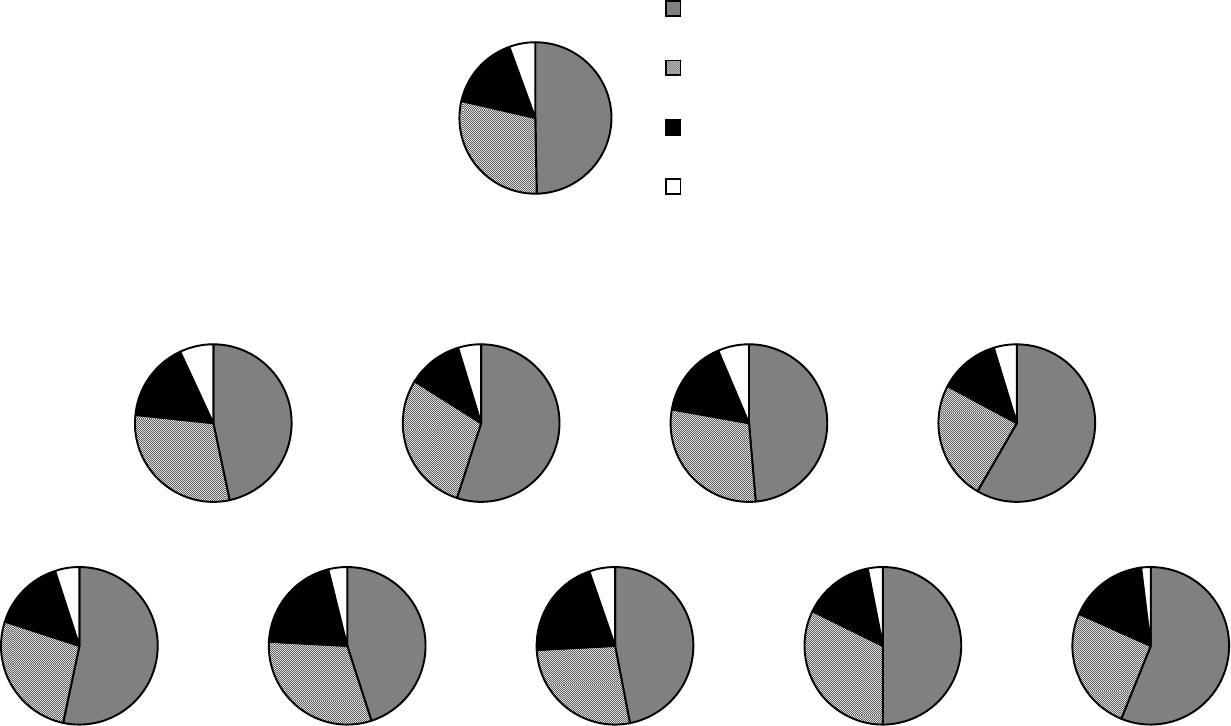
Figure 3.1 Time loss
*
by Sport
Overall
<1 Week
1-3 Weeks
>3 Weeks
Other/
unknown
Boys' Football Boys' Soccer Girls' Soccer Girls' Volleyball
Boys' Basketball Girls' Basketball Boys' Wrestling Boys' Baseball Girls' Softball
* Time-loss represents the amount of time athlete was kept out of practice and/or competition as a result of the injury.
15
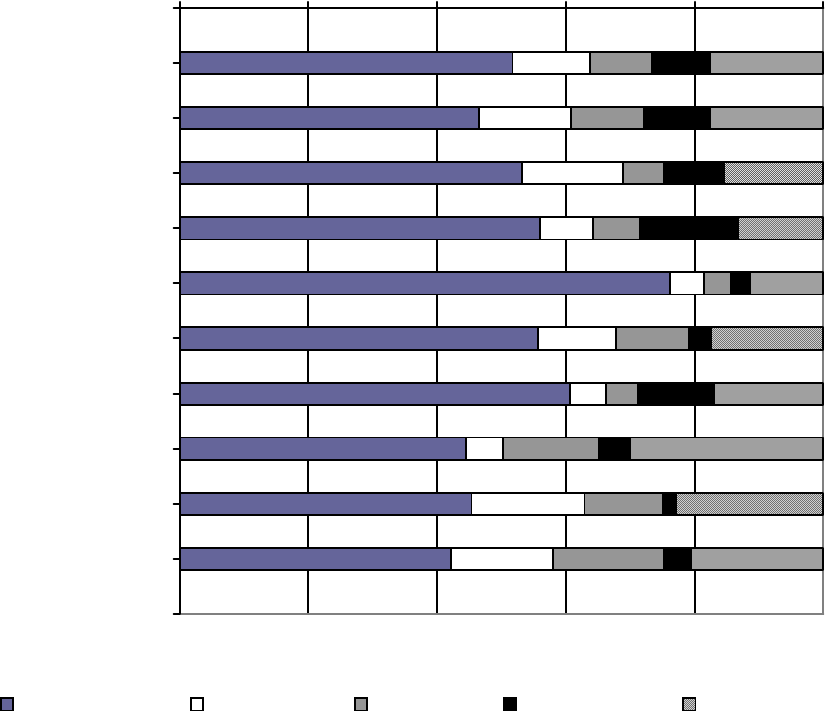
Figure 3.1 highlights:
• Time loss due to injury was similar among all sports: 49.7% of injuries kept the athlete
out of practice and/or competition less than 1 week, 28.9% kept the athlete out from 1-3
weeks, and 15.8% kept the athlete out for more than 3 weeks.
• Volleyball (58.3%) and softball (56.1%) had the greatest proportion of injuries keeping
athletes out for less than 1 week.
• The highest proportions of injuries keeping athletes out of play for more than 3 weeks
were seen in wrestling (20.5%) and girls’ basketball (20.1%).
Figure 3.2 Type of Injury by Sport
0% 20% 40% 60% 80% 100%
Overall
Boys' Football
Boys' Soccer
Girls' Soccer
Girls' Volleyball
Boys' Basketball
Girls' Basketball
Boys' Wrestling
Boys' Baseball
Girls' Softball
Sport
Injury type
Sprain/Strain Contusion Fracture Concussion Other/unknown
16
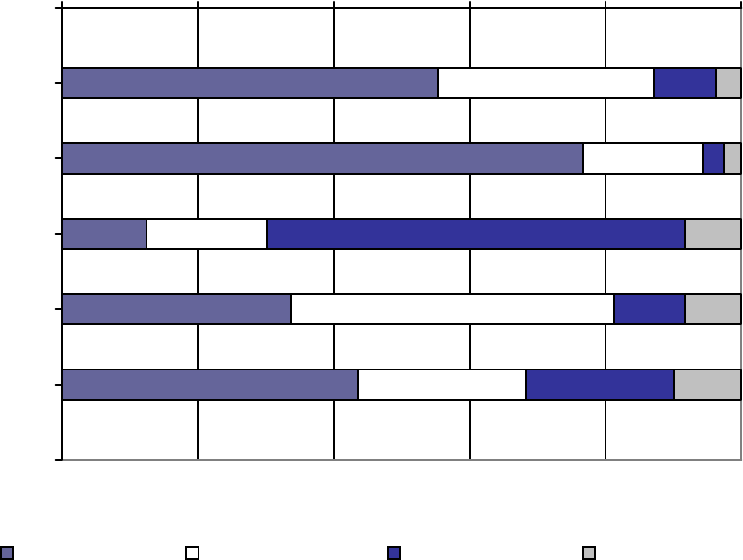
17
Figure 3.2 highlights:
• Over 50% of injuries in all sports were sprains/strains.
• Softball had the highest proportion of fractures (17.2%), followed by wrestling (14.8%).
• Girls’ soccer had the highest proportion of concussion (15.2%), followed by girls’
basketball (11.8%).
Figure 3.3 Time Loss
*
by Injury Type, All Sports
0% 20% 40% 60% 80% 100%
Strain/Sprain
Contusion
Fracture
Concussion
Other/unknown
Injury diagnosis
Time loss
<1 Week 1-3 Weeks >3 Weeks Other/unknown
* Time-loss represents the amount of time athlete was kept out of practice and/or competition as a result of the
injury.
Figure 3.3 highlights:
• One-third of athletes sustaining a concussion returned to play within 1 week (33.7%),
with 47.5 returning in 1-3 weeks.
• The majority of athletes sustaining a fracture took over 3 weeks to return (61.5%).
• The majority of athletes sustaining a strain/sprain or a contusion were able to return to
practice and/or competition in less than 1 week (55.4% and 76.6%, respectively).

Table 3.2 Body Site of Injury by Sport
Overall
Boys’
Football
Boys’
Soccer
Girls’
Soccer
Girls’
Volleyball
Boys’
Basketball
Girls’
Basketball
Boys’
Wrestling
Boys’
Baseball
Girls’
Softball
Head/Face
12.2% 11.3% 12.0% 16.3% 3.5% 10.8% 14.0% 11.4% 13.7% 18.1%
Neck
2.2% 4.1% 0.0% 0.2% 0.3% 0.7% 0.3% 8.0% 0.3% 0.6%
Shoulder
7.8% 11.8% 1.6% 0.6% 5.2% 3.5% 1.2% 17.3% 19.7% 10.9%
Arm
4.0% 4.9% 0.7% 0.7% 3.6% 2.1% 1.5% 12.3% 10.1% 6.3%
Hand/Wrist
7.8% 10.1% 3.3% 3.1% 7.7% 8.5% 6.5% 7.3% 10.7% 17.3%
Trunk
9.0% 9.4% 11.9% 4.0% 13.2% 8.4% 4.3% 13.3% 9.6% 5.7%
Leg
12.6% 10.6% 21.0% 17.2% 3.5% 9.4% 12.9% 6.0% 14.5% 10.1%
Knee
14.2% 15.2% 14.8% 16.6% 13.0% 9.8% 15.9% 13.8% 6.7% 11.2%
Ankle/Foot
26.3% 18.1% 31.4% 35.1% 45.2% 45.3% 40.5% 8.5% 10.9% 17.4%
Other/unknown
3.9% 4.5% 3.3% 6.0% 4.7% 1.6% 3.0% 2.1% 3.8% 2.4%
Total
100% 100%
100% 100% 100% 100% 100% 100% 100% 100%
Table 3.2 highlights:
• The ankle/foot was the most commonly injured body site among boys’ football (18.1%), boys’ soccer (31.4%), girls’ soccer (35.1%),
girls’ volleyball (45.2%), boys’ basketball (45.3%) and girls’ basketball (40.5%).
• The head/face accounted for larger proportions of injuries in girls’ softball (18.1%), girls’ soccer (16.3%) and girls’ basketball
(14.0%) than other sports.
• The neck accounted for a greater proportion of injuries in wrestling (8.0%) compared with all other sports (IPR= 4.62, 95% CI:2.92-
7.29).
18
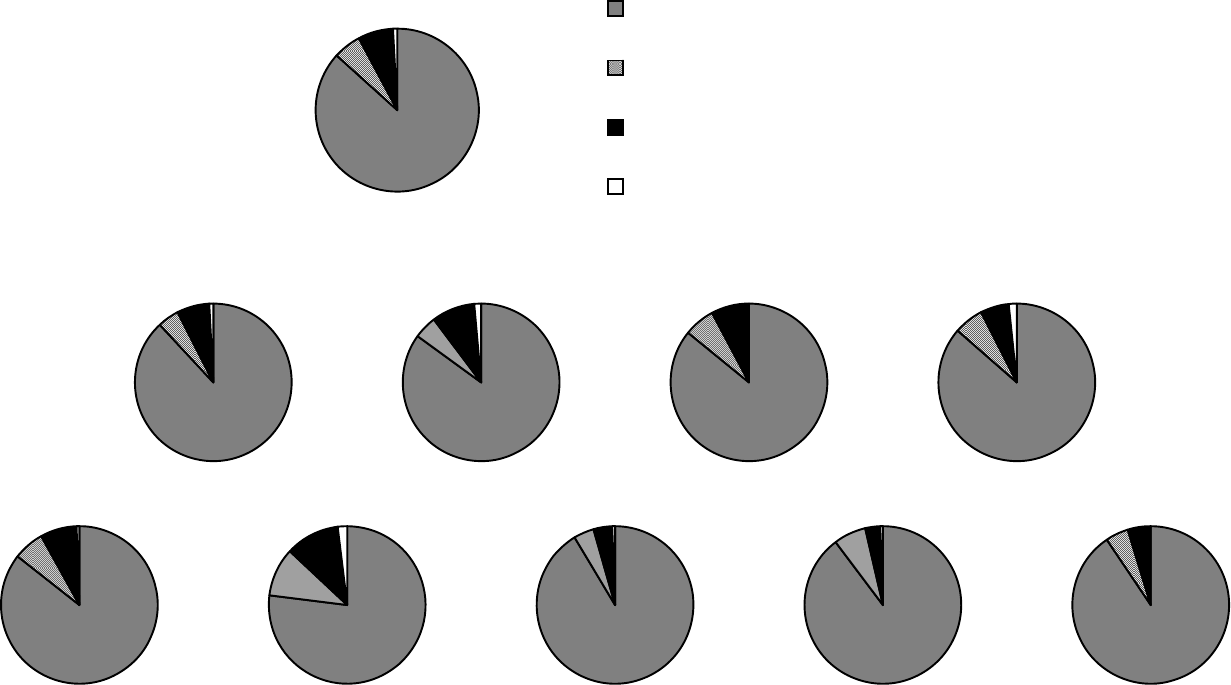
19
Boys' Basketball Girls' Basketball Boys' Wrestling Boys' Baseball Girls' Softball
Boys' Football Boys' Soccer Girls' Soccer Girls' Volleyball
Overall
New injury
Recurrence (previous academic year)
Recurrence (this academic year)
Other/unknown
Figure 3.3 New and Recurring Injuries by Sport

Figure 3.3 highlights:
• The patterns of new and recurring injuries were similar between sports, with the majority
of injuries being new (86.7%).
• Girls’ basketball had the highest proportion of recurring injuries (21.1%).
Figure 3.4 Mechanism of Injury by Sport
0% 20% 40% 60% 80% 100%
Overall
Boys' Football
Boys' Soccer
Girls' Soccer
Girls' Volleyball
Boys' Basketball
Girls' Basketball
Boys' Wrestling
Boys' Baseball
Girls' Softball
Sport
Injury mechanism
Contact with person Contact with playing surface Contact with playing apparatus
No contact Illness Other/unknown
20

Figure 3.4 highlights:
• Overall, contact with another person accounted for half (48.9%) of all injuries, followed
by no contact (18.9%) and contact with the playing surface (18.4%).
• Contact with another person caused the greatest proportion of injuries in boys’ football
(67.0%) and the smallest proportion of injuries in boys’ baseball (11.1%) and girls’
softball (12.5%).
• Contact with playing apparatus caused the greatest proportion of injuries in boys’
baseball (31.5%) and girls’ softball (38.7%).
Table 3.3 Proportion of Injuries Related to Illegal Activity by Sport
% of injuries related
to illegal activity
Overall 6.2%
Boys’ Football 1.2%
Boys’ Soccer 10.6%
Girls’ Soccer 12.1%
Girls’ Volleyball 0%
Boys’ Basketball 11.1%
Girls Basketball 13.7%
Boys’ Wrestling 6.4%
Boys’ Baseball 3.8%
Girls’ Softball 1.3%
Table 3.3 highlights:
• Basketball (12.5%, both genders combined) and soccer (11.3%, both genders combined)
had greater proportions of injuries attributable to illegal activity (IPR=2.37, 95% CI:
1.50-3.77 and IPR=2.96, 95% CI: 1.89-4.64) compared with all other sports combined
(1.8%).
21
3.2 Additional General Injury Information
The majority of all injuries occurred during the regular season (76.8%), with 20.5%
occurring during preseason and 2.7% occurring during postseason. Overall, 51.4% of injuries
occurred during a competition, 46.3% occurred during a practice, and 2.3% occurred during
other training. However, this pattern varied between sports, with competition representing larger
proportions of injuries in girls’ soccer (63.8%) and boys’ soccer (53.9%) and practice
representing a larger proportion of injuries in wrestling (62.5%).
The majority of practice injuries occurred between 30-60 minutes (27.3%) and between
60-90 minutes (31.4%) into practice. For competition injuries, over half occurred during the
middle of the competition (53.1%), with 29.2% occurring at the end of competition and 14.5% at
the beginning. A similar proportion of competition injuries occurred while at home (50.1%) as
while away (48.0%), with 2.0% occurring at a neutral site.
Surgery was required following 5.2% of the injury events. This proportion was highest
among baseball (9.9%) and wrestling (7.1%) and was lowest among boys’ soccer (3.2%) and
volleyball (4.5%). A previous, unrelated injured was experienced earlier in the season by 14.0%
of injured athletes. This proportion was highest among football (18.2%) and wrestling (17.7%)
and lowest among volleyball (3.3%) and softball (8.8%).
Overall, 9.0% of athletes sustained a concussion. During these events, 41.2% of athletes
experienced a headache, 15.6% experienced dizziness/unsteadiness, 8.8% experienced
confusions or disorientation, and 6.5% experienced amnesia. A loss of consciousness was
sustained by 4.0%. While 15.2% of concussed athletes reported symptoms to be resolved within
an hour, 37.9% took up to a day to resolve, 35.7% took between 1 and 3 days, and 26.5% took 4
or more days.
22

4. Sport-Specific Injury Epidemiology
4.1 Boys’ Football
The 1,880 reported football injuries represent an estimated 523,368 injuries that occurred
nationally during the 2005-2006 academic year. Table 4.1 presents demographic characteristics
of injured football athletes.
Table 4.1 Demographic Characteristics of Injured Boys’ Football Athletes
Mean St. Dev. Minimum Maximum
Age (years)
15.9 1.3 13 19
Height (inches)
69.9 3.1 53 79
Weight (pounds)
178.4 33.2 94 327
n*
†
%
Freshmen
105,232 20.3%
Sophomores
128,836 24.9%
Juniors
121,478 23.5%
Seniors
162,293 31.3%
Total
517,839 100%
* “n” represents weighted estimates representing all US boys’ football athletes
† Cases with missing/unknown class were excluded from this table
Table 4.1 highlights:
• The mean body mass index (BMI) for injured football athletes (25.7).
• There were a higher proportion of seniors among injured athletes than freshmen,
sophomores, and juniors.
Running backs (15.8%), linebackers (14.4%), and wide receivers (11.7%) were most
commonly injured. The majority of injuries occurred while the player was between the 20-yard
lines (71.6%), with 15.3% occurring in the red zone, 11.5% occurring off field, and 1.6%
23

24
occurring in the end zone. The playing surface upon which injuries were sustained was typically
grass (85.4%), followed by artificial fill (12.9%). Table 4.2 presents the mechanism of football
injury by the injury type.
Table 4.2 Mechanism of Boys’ Football Injury by Type of Injury
Sprain/Strain,
n=238,825
Contusion,
n=75,022
Fracture,
n=57,649
Concussion,
n=53,296
Other,
n=84,848
Being tackled
28.1% 39.1% 28.3% 36.0% 17.8%
Tackling
17.6% 22.9% 22.9% 33.6% 26.4%
Blocking
16.8% 8.5% 17.5% 14.5% 14.2%
Being blocked
9.1% 12.9% 6.1% 14.0% 10.5%
Stepped on/
fell on/ kicked
8.1% 11.0% 10.9% 0.2% 4.9%
Other
20.4% 5.6% 14.2% 1.7% 26.2%
Total
100% 100% 100% 100% 100%
Table 4.2 highlights:
• Overall, being tackled (28.9%) and tackling (22.1%) caused the greatest proportion of
injuries.
Figure 4.1 presents the type of injury by body site. Figure 4.1 highlights:
• Concussions made up the majority (66.5%) of head/face/neck injuries, followed by
strain/sprain (15.1%), and nerve injury (6.3%).
• Strains/sprains were more common among lower extremity injuries (67.7%) than trunk
injuries (52.2%) and upper extremity injuries (30.9%).
• Fractures made up a greater proportion of upper extremity injuries (27.2%), with fewer
fractures occurring to the lower extremities (5.7%) and trunk (4.8%).
• Less than 0.2% of injuries were due to dehydration or heatstroke/heat exhaustion.

25
Figure 4.1 Type of Boys’ Football Injury by Body Site
Trunk
Sprain/Strain
Contusion
Fracture
Other
Head/Face/Neck
Concussion
Strain/Sprain
Nerve injury
Other
Upper Extremities
Sprain/Strain
Contusion
Fracture
Dislocation
Lower Extremities
Sprain/Strain
Contusion
Fracture
Other
Other

4.2 Boys’ Soccer
The 378 reported boys’ soccer injuries represent an estimated 223,386 injuries that
occurred nationally during the 2005-2006 academic year. Table 4.3 presents demographic
characteristics of injured boys’ soccer athletes.
Table 4.3 Demographic Characteristics of Injured Boys’ Soccer Athletes
Mean St. Dev. Minimum Maximum
Age (years)
16.1 1.2 13 19
Height (inches)
69.1 3.5 57 96
Weight (pounds)
153.1 22.2 102 238
n*
†
%
Freshmen
28,158 12.9%
Sophomores
49,879 22.8%
Juniors
67,857 31.0%
Seniors
72,996 33.3%
Total
218,890 100%
* “n” represents weighted estimates representing all US boys’ soccer athletes
† Cases with missing/unknown class were excluded from this table
Table 4.3 highlights:
• The mean BMI for injured boys’ soccer athletes was 22.5.
• There was a lower proportion of freshmen among injured athletes.
Boys’ soccer forwards (33.5%) and midfielders (33.5%) sustained the largest proportion
of reported injuries, with defenders accounting for 23.5% and goalkeepers for 9.5%. The most
common field location of injury was the offensive side of the field from the top of the goal box
extended to the center line (39.8%). Defensively, this area of the field accounted for 18.6% of
all injuries. Table 4.4 presents mechanism of boys’ soccer injury by the injury type.
26

27
Table 4.4 Mechanism of Boys’ Soccer Injury by Type of Injury
Sprain/Strain,
n=117,411
Contusion,
n=34,332
Fracture,
n=13,436
Concussion,
n=20,826
Other,
n=31,633
General play
18.5% 17.8% 12.9% 10.6% 31.9%
Ball handling/
dribbling
14.9% 23.8% 18.0% 0.0% 7.3%
Shooting/ passing
19.6% 6.2% 19.4% 0.0% 5.4%
Chasing loose ball
16.1% 8.6% 10.1% 1.4% 7.8%
Slide tackle
7.8% 5.3% 11.6% 4.6% 10.7%
Goaltending
5.1% 12.2% 0.0% 20.5% 8.7%
Heading ball
1.9% 6.4% 12.5% 40.5% 4.3%
Defending
8.1% 5.1% 13.5% 3.7% 3.0%
Other
7.9% 14.6% 2.1% 18.7% 20.9%
Total
100% 100% 100% 100% 100%
Table 4.4 highlights:
• Overall, general play (19.2%) caused the greatest proportion of injuries, followed by ball
handling/dribbling (14.0%) and shooting/passing (13.5%).
• The majority of concussions were caused by heading the ball (40.5%) and goaltending
(20.5%).
Figure 4.2 presents type of injury by body site. Figure 4.2 highlights:
• The majority of head/face/neck injuries were concussions (78.3%), with fewer lacerations
(5.0%) and contusions (3.9%).
• Fractures made up a larger proportion of upper extremity injuries (37.8%) than trunk
(11.9%) or lower extremity injuries (2.4%).

Figure 4.2 Type of Boys’ Soccer Injury by Body Site
Head/Face/Neck
Concussion
Contusion
Laceration
Upper Extremities
Sprain/Strain
Contusion
Other
Fracture
Hyperextension
Trunk
Sprain/Strain
Contusion
Fracture
Other
Other
Lower Extremities
Sprain/Strain
Contusion
Fracture
Other
28

4.3 Girls’ Soccer
The 346 reported girls’ soccer injuries represent an estimated 193,672 injuries that
occurred nationally during the 2005-2006 academic year. Table 4.5 presents demographic
characteristics of injured girls’ soccer athletes.
Table 4.5 Demographic Characteristics of Injured Girls’ Soccer Athletes
Mean St. Dev. Minimum Maximum
Age (years)
16 1.2 13 18
Height (inches)
64.7 3.1 50 86
Weight (pounds)
129.1 16.9 90 210
n
*
†
%
Freshmen
33,818 17.7%
Sophomores
41,990 22.0%
Juniors
70,219 36.9%
Seniors
44,522 23.4%
Total
190,549 100%
* “n” represents weighted estimates representing all US girls’ soccer athletes
† Cases with missing/unknown class were excluded from this table
Table 4.5 highlights:
• The mean BMI for girls’ soccer athletes was 21.7.
• Juniors made up a higher proportion of injured athletes than any other class.
A similar number of girls’ soccer injuries occurred among forwards (30.5%), midfielders
(31.1%), and defenders (29.1%). Goalkeepers accounted for 8.7% of injuries. Similarly to boys’
soccer, in girls’ soccer injuries occurred most often between the top of the goal box and the
center line while on offense (31.4%), followed by this same area while on defense (17.1%) and
29

30
while defending in the goal box (12.5%). Table 4.6 presents mechanism of injury by the injury
type.
Table 4.6 Mechanism of Girls’ Soccer Injury by Type of Injury
Sprain/Strain,
n=108,556
Contusion,
n=15,856
Fracture,
n=14,068
Concussion,
n=29,425
Other,
n=25,766
Defending
12.3% 28.7% 21.5% 15.3% 14.9%
General play
16.6% 7.0% 10.9% 7.9% 17.9%
Ball handling/
dribbling
16.2% 16.6% 26.6% 6.1% 6.1%
Chasing loose
ball
16.5% 9.6% 4.4% 11.9% 7.0%
Shooting/
passing
15.2% 7.4% 6.4% 0.7% 8.9%
Slide tackle
7.3% 0% 18.2% 5.1% 6.1%
Goaltending
3.3% 28.2% 8.5% 8.5% 0%
Heading ball
2.0% 2.5% 0% 37.2% 3.0%
Other
10.6% 0% 3.4% 7.2% 36.0%
Total
100% 100% 100% 100% 100%
Table 4.6 highlights:
• Defending (15.1%), general play (14.2%), and ball handling/dribbling (14.2%) led to the
greatest proportion of injuries.
• The greatest proportion of concussions were caused by heading the ball (37.2%) and
defending (15.3%).
Figure 4.3 presents the type of injury by body site. Figure 4.3 highlights:
• Head/face/neck injuries were most commonly concussions (85.1%), with fewer
sprains/strains (5.3%), contusions (5.0%), and fractures (2.6%).
• Fractures were more common among upper extremity injuries (40.7%) than lower
extremity injuries (6.6%), and were absent among trunk injuries.
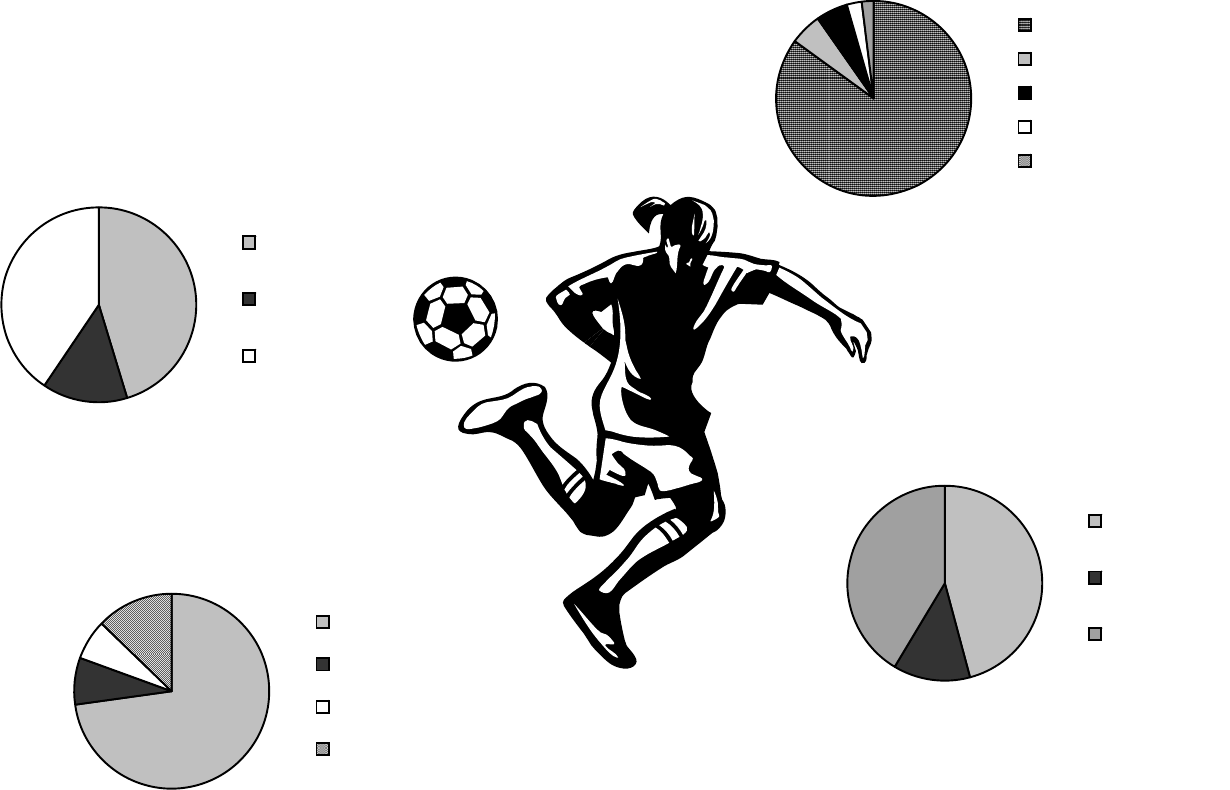
Figure 4.3 Type of Injury by Body Site for Girls’ Soccer Injuries
Head/Face/Neck
Concussion
Sprain/Strain
Contusion
Fracture
Upper Extremities
Sprain/Strain
Other
Contusion
Fracture
Trunk
Sprain/Strain
Contusion
Lower Extremities
Sprain/Strain
Contusion
Fracture
Other
Other
31

4.4 Girls’ Volleyball
The 203 reported volleyball injuries represent an estimated 83,530 injuries that occurred
nationally during the 2005-2006 academic year. Table 4.7 presents demographic characteristics
of injured volleyball athletes.
Table 4.7 Demographic Characteristics of Injured Girls’ Volleyball Athletes
Mean St. Dev. Minimum Maximum
Age (years)
15.7 1.3 13 18
Height (inches)
66.2 3.5 56 79
Weight (pounds)
140.8 22.4 95 225
n
*
†
%
Freshmen
19,357 23.2%
Sophomores
23,161 27.8%
Juniors
17,604 21.1%
Seniors
23,188 27.8%
* “n” represents weighted estimates representing all US girls’ volleyball athletes
† Cases with missing/unknown class were excluded from this table
Table 4.7 highlights:
• The mean BMI for girls’ volleyball athletes was 22.6.
• Injuries were evenly distributed among the classes.
The largest proportion of volleyball injures occurred among outside hitters (34.5%),
followed by the middle blocker (27.1%), the setter (19.6%), the opposite/diagonal player
(10.1%), and the librero (4.4%). The middle forward portion of the court was the most common
location of injury (33.7%), followed by the right forward (23.4%), the left forward (13.5%), and
the left back (12.4%). Table 4.8 presents mechanism of injury by the injury type.
32

33
Table 4.8 Mechanism of Girls’ Volleyball Injury by Type of Injury
Sprain/Strain,
n=63,669
Contusion,
n=4,367
Fracture,
n=3,468
Concussion,
n=2,568
Other,
n=9,458
Blocking
36.2% 3.4% 42.1% 0% 7.1%
Passing
13.8% 0% 34.4% 41.7% 8.5%
Digging
8.3% 81.3% 4.8% 17.3% 12.3%
Spiking
12.6% 0% 0% 0% 10.4%
General play
7.6% 0% 8.0% 10.8% 33.3%
Setting
10.3% 15.2% 6.4% 0% 6.0%
Other
11.2% 0% 4.3% 30.2% 22.3%
Total
100% 100% 100% 100% 100%
Table 4.8 highlights:
• Blocking (30.5%) accounted for the most injuries, followed by passing (14.3%) and
digging (12.8%).
• Almost half of all concussions were caused by passing (41.7%).
Figure 4.4 presents type of injury by body site. Figure 4.4 highlights:
• Concussion made up 80.8% of head/face/neck injuries, with fewer contusions (12.1%)
and lacerations (7%).
• The majority of lower extremity (85.6%), upper extremity (78.6%), and trunk (67.8%)
injuries were sprains/strains.
• Infections/inflammation accounted for 12.2% of trunk injuries.
• Tendonitis accounted for 8.8% of upper extremity injuries.
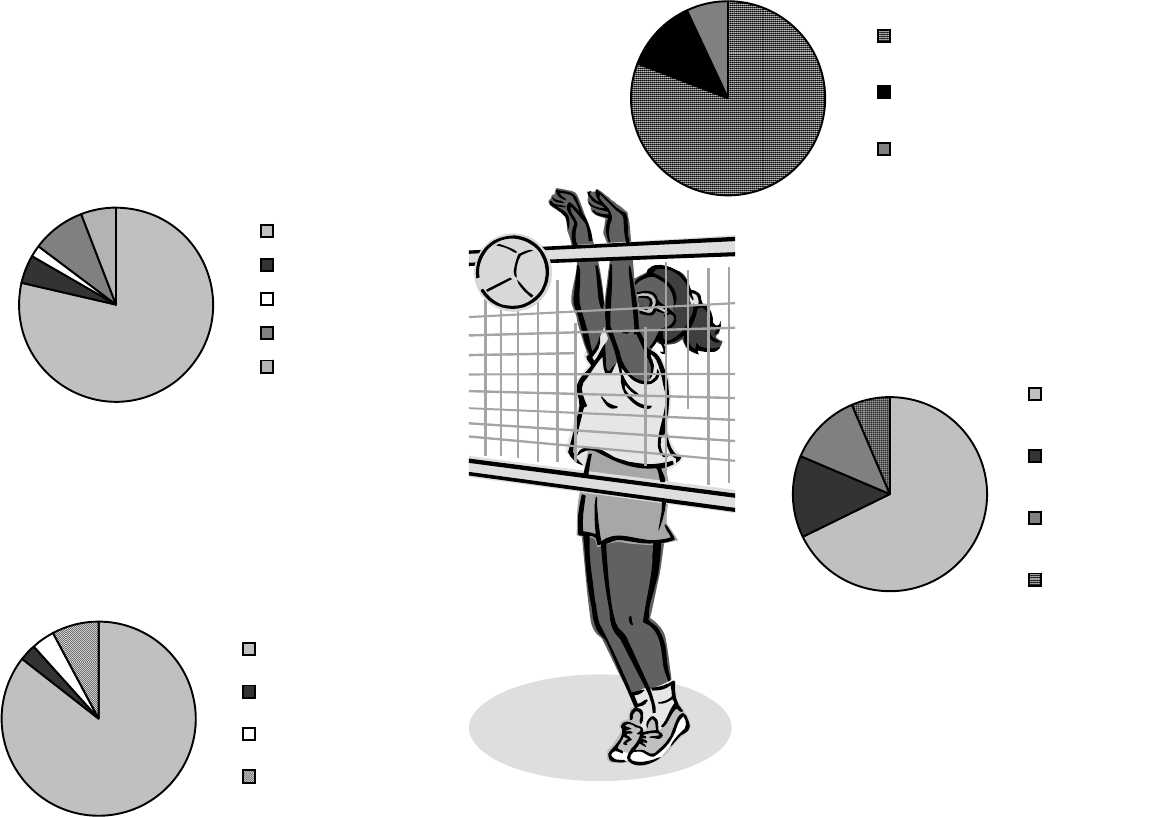
Figure 4.4 Type of Injury by Body Site for Girls’ Volleyball Injuries
Head/Face/Neck
Concussion
Contusion
Laceration
Upper Extremities
Sprain/Strain
Contusion
Fracture
Tendonitis
Trunk
Sprain/Strain
Contusion
Infection/
Inflammation
Other
Lower Extremities
Sprain/Strain
Contusion
Fracture
Stress
fracture
Other
34

4.5 Boys’ Basketball
The 416 reported boys’ basketball injuries represent an estimated 101,105 injuries that
occurred nationally during the 2005-2006 academic year. Table 4.9 presents demographic
characteristics of injured boys’ basketball athletes.
Table 4.9 Demographic Characteristics of Injured Boys’ Basketball Athletes
Mean St. Dev. Minimum Maximum
Age (years)
16.1 1.2 13 19
Height (inches)
71.5 3.4 56 81
Weight (pounds)
167.8 26.1 105 305
n
*
†
%
Freshmen
19,029 19.2%
Sophomores
26,477 26.7%
Juniors
28,366 28.7%
Seniors
25,133 25.4%
Total
99,005 100%
* “n” represents weighted estimates representing all US boys’ basketball athletes
† Cases with missing/unknown class were excluded from this table
Table 4.9 highlights:
• The mean BMI for injures boys’ basketball athletes was 23.1.
• Injuries were distributed evenly throughout the classes, with freshmen accounting for
slightly fewer injuries than upperclassmen.
Among boys’ basketball, forwards (43.9%) and guards (43.8%) accounted for the most
injuries, followed by centers (11.9%). Half of all injuries occurred inside either the defensive or
offensive lane (31.7% and 28.3%, respectively). The next most common location was while the
player was on offense or defense between the 3-point arc and the center lane (10.5% and 7.2%,
35

36
respectively). Being outside of the 3-point arc while playing offense or defense accounted for
8.3% and 6.4% of all reported injures, respectively. Table 4.10 presents mechanism of injury by
the injury type.
Table 4.10 Mechanism of Boys’ Basketball Injury by Type of Injury
Sprain/Strain,
n=56,323
Contusion,
n=12,265
Fracture,
n=11,391
Concussion,
n=3,513
Other,
n=17,145
General play
12.6% 11.4% 8.7% 0% 30.5%
Rebounding
40.2% 13.2% 34.7% 33.1% 17.4%
Defending
12.3% 28.2% 19.9% 5.8% 9.2%
Shooting
10.9% 3.4% 7.5% 14.1% 5.4%
Dribbling
7.7% 12.6% 1.9% 11.4% 9.3%
Chasing loose ball
6.4% 14.5% 7.7% 28.3% 3.6%
Other
9.8% 16.6% 19.7% 7.4% 24.5%
Total
100% 100% 100% 100% 100%
Table 4.10 highlights:
• Rebounding accounted for the greatest proportion of injures (32.2%), followed by general
play (14.6%) and defending (14.4%).
• Chasing loose balls accounted for 28.3% of concussions.
Figure 4.5 presents type of injury by body site. Figure 4.5 highlights:
• Head/face/neck injuries were comprised of concussions (30.2%), fractures (22.8%),
lacerations (20.4%), and contusions (9.1%).
• Strains/sprains were more common among lower extremity injuries (71.8%) than trunk
(41.4%) and upper extremity (35.9%) injuries.
• Fracture was more common among upper extremity injuries (29.4%) than trunk (6.7%)
and lower extremity injuries (5.7%).
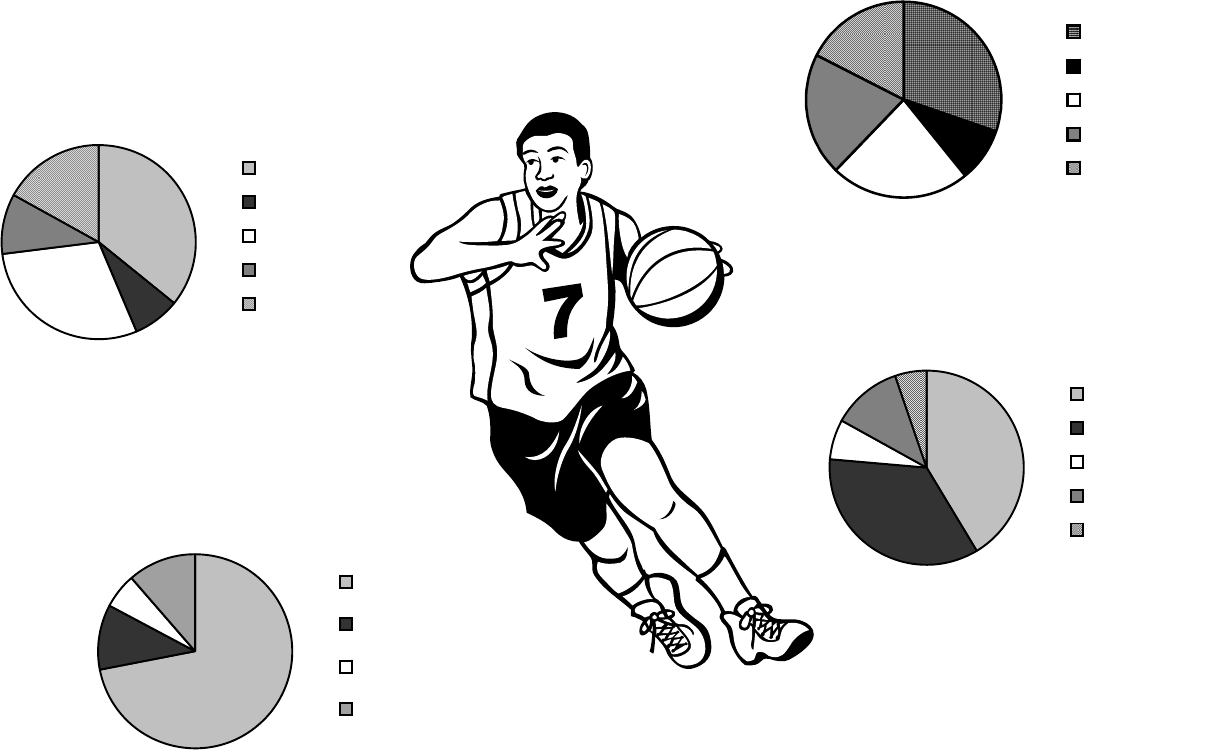
37
Figure 4.5 Type of Injury by Body Site for Boys’ Basketball Injuries
Head/Face/Neck
Trunk
Sprain/Strain
Contusion
Fracture
Inflammation
Concussion
Upper Extremities
Sprain/Strain
Contusion
Fracture
Dislocation
Other
Other
Lower Extremities
Sprain/Strain
Contusion
Fracture
Other
Contusion
Fracture
Laceration
Other

4.6 Girls’ Basketball
The 392 reported boys’ basketball injuries represent an estimated 110,891 injuries that
occurred nationally during the 2005-2006 academic year. Table 4.11 presents demographic
characteristics of injured girls’ basketball athletes.
Table 4.11 Demographic Characteristics of Injured Girls’ Basketball Athletes
Mean St. Dev. Minimum Maximum
Age (years)
15.6 1.2 13 18
Height (inches)
66.5 3.5 52 74
Weight (pounds)
138.1 23 94 236
n
*
†
%
Freshmen
35,837 32.4%
Sophomores
29,445 26.6%
Juniors
27,656 25.0%
Seniors
17,806 16.1%
Total
110,744 100%
* “n” represents weighted estimates representing all US girls’ basketball athletes
† Cases with missing/unknown class were excluded from this table
Table 4.11 highlights:
• The mean BMI for girls’ basketball athletes was 22.0.
• There were twice as many freshmen injured as seniors.
In girls’ basketball, half of all injuries were sustained by guards (50.5%), with forwards
sustaining 30.7% and centers sustaining 17.4%. Similarly to boys’ basketball, the most common
court location of injury was being on defense or offense inside the lane (23.3% and 22.7%,
respectively), followed by being on offense or defense between the 3-point arc and the inside
38

39
lane (12.2% and 10.2%, respectively) and being on offense or defense while outside of the 3-
point arc (10.3% and 9.2%, respectively).
Table 4.12 Mechanism of Girls’ Basketball Injury by Type of Injury
Sprain/Strain,
n=67,259
Contusion,
n=6,256
Fracture,
n=5,400
Concussion,
n=13,136
Other,
n=18,370
General play
18.5% 28.0% 5.4% 3.3% 38.6%
Rebounding
21.2% 21.3% 24.8% 16.4% 8.7%
Defending
16.9% 9.8% 12.1% 21.9% 9.2%
Conditioning
13.9% 0% 9.1% 0% 16.2%
Dribbling
9.3% 0% 5.8% 18.7% 3.9%
Chasing loose ball
7.4% 19.8% 14.0% 10.4% 6.5%
Other
12.9% 21.0% 28.8% 29.3% 16.9%
Total
100% 100% 100% 100% 100%
Table 4.12 highlights:
• General play accounted for the greatest proportion of injuries (19.8%), followed by
rebounding (18.7%) and defending (15.6%).
Figure 4.6 presents the types of injury by body site. Figure 4.6 highlights:
• The majority of head/face/neck injuries were concussions (82.8%), followed by fractures
(7.5%) and contusions (4.9%).
• Sprains/strains made up a greater proportion of lower extremity injuries (74.9%)
compared with upper extremity (53.7%) and trunk (51.1%) injuries.
• There was a greater proportion of fractures among upper extremity injuries (19.7%)
compared to trunk injuries (9.5%). There were no fractures among lower extremity
injuries.
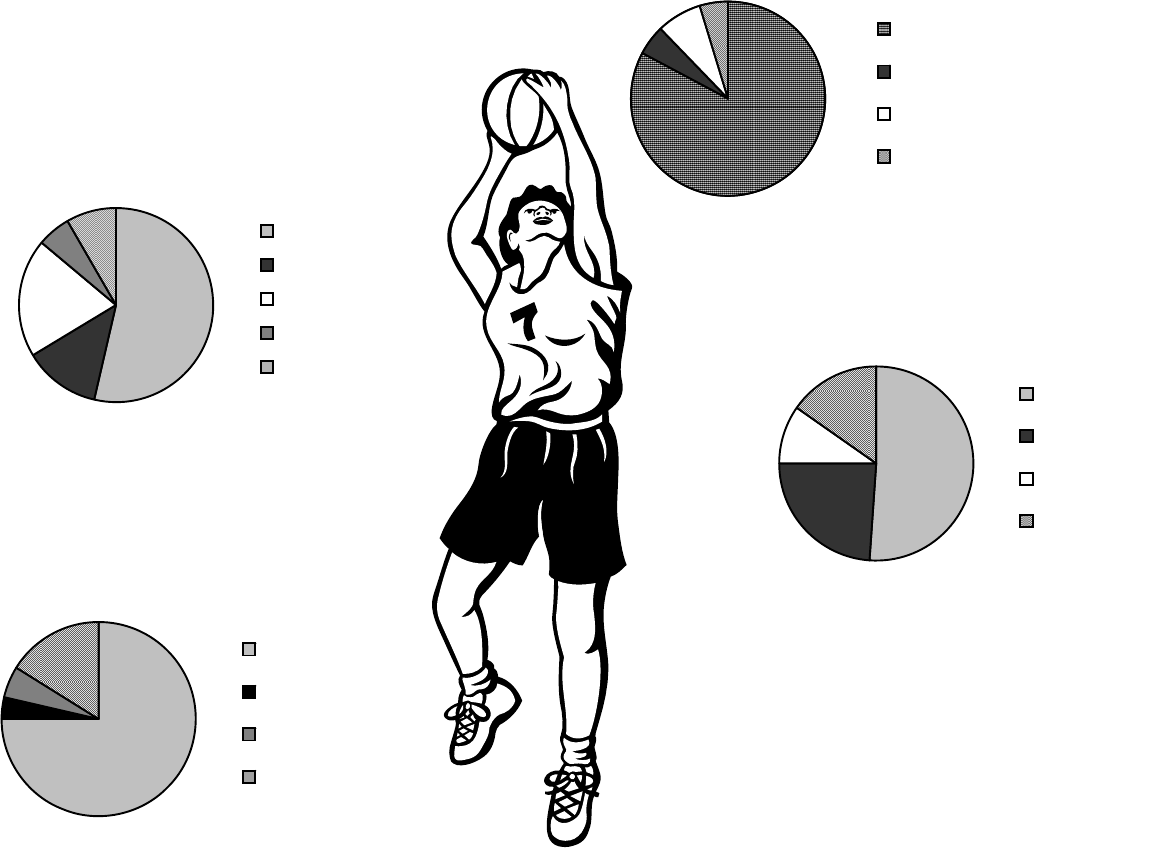
40
Trunk
Sprain/Strain
Contusion
Fracture
Other
Head/Face/Neck
Concussion
Figure 4.6 Type of Injury by Body Site for Girls’ Basketball Injuries
Contusion
Fracture
Laceration
Other
Concussion
Head/Face/Neck
Contusion
Fracture
Other
Upper Extremities
Sprain/Strain
Contusion
Lower Extremities
Sprain/Strain
Contusion
Tendonitits
Fracture
Dislocation
Other
Other

4.7 Boys’ Wrestling
The 430 reported wrestling injuries represent an estimated 110,889 injuries that occurred
nationally during the 2005-2006 academic year. Table 4.13 presents demographic characteristics
of injured wrestling athletes.
Table 4.13 Demographic Characteristics of Injured Boys’ Wrestling Athletes
Mean St. Dev. Minimum Maximum
Age (years)
15.9 1.2 14 18
Height (inches)
67.8 3.7 51 75
Weight (pounds)
155.5 36.6 98 310
n
*
†
%
Freshmen
26,013 23.5%
Sophomores
28,159 25.4%
Juniors
28,661 25.9%
Seniors
27,815 25.1%
Total
110,648 100%
* “n” represents weighted estimates representing all US wrestling athletes
† Cases with missing/unknown class were excluded from this table
Table 4.13 highlights:
• The mean BMI for injured boys’ wrestling athletes was 23.8.
• Injuries were distributed evenly among classes.
The wrestling injuries reported were fairly uniformly distributed among the various
weight classes. The majority of injuries occurred within the circle (86.4%), with 10.1% of
injuries occurring off the mat and 3.6% sustained out of bounds. Table 4.14 presents
mechanisms of wrestling injury by injury type.

42
Table 4.14 Mechanism of Boys’ Wrestling Injury by Type of Injury
Sprain/Strain,
n=49,326
Contusion,
n=6,436
Fracture,
n=16,459
Concussion,
n=5,417
Other,
n=33,151
Takedown
29.3% 58.3% 47.3% 52.7% 31.8%
Sparring
17.6% 10.7% 16.6% 27.0% 7.8%
Near fall
6.7% 15.9% 11.6% 0% 9.5%
Escape
11.0% 0% 3.8% 7.9% 9.1%
Fall
10.1% 0% 13.1% 4.2% 0.9%
Other
25.3% 15.0% 7.8% 8.3% 40.9%
Total
100% 100% 100% 100% 100%
Table 4.14 highlights:
• The takedown (35.8%) accounted for the greatest proportion of injuries, followed by
sparring (14.7%).
• More than half of all concussions occurred during takedowns.
Figure 4.7 presents injury type by body site. Figure 4.7 highlights:
• Head/face/neck injuries were composed of concussions (25.1%), sprains/strains (27.3%),
fractures (9.3%), and infections (13.1%).
• Strains/sprains made up the largest proportion of upper extremity injuries (39.6%),
followed by fractures (25.2%), dislocations (11.6%), and hyperextensions (6.1%).
• Lower extremity injuries were composed mainly of sprains/strains (61.3%), followed by
torn cartilage (8.5%), fracture (7.2%), and contusion (3.8%).
• Potential skin infections accounted for approximately 9.7% of reported injuries, with six
participating study schools reporting multiple occurrences.

43
Figure 4.7 Type of Injury by Body Site for Boys’ Wrestling Injuries
Trunk
Sprain/Strain
Contusion
Fracture
Other
Head/Face/Neck
Concussion
Strain/Sprain
Fracture
Infection
Other
Upper Extremities
Sprain/Strain
Fracture
Dislocation
Hyperextension
Lower Extremities
Sprain/Strain
Contusion
Fracture
Torn cartilage
Other
Other

4.8 Boys’ Baseball
The 221 reported baseball injuries represent an estimated 69,151 injuries that occurred
nationally during the 2005-2006 academic year. Table 4.15 presents demographic characteristics
of injured baseball athletes.
Table 4.15 Demographic Characteristics of Injured Boys’ Baseball Athletes
Mean St. Dev. Minimum Maximum
Age (years)
16.1 1.3 14 19
Height (inches)
69.5 3.4 60 76
Weight (pounds)
164.2 28.8 110 260
* “n” represents weighted estimates representing all boys’ baseball US athletes
n
*
†
%
Freshmen
18,056 26.4%
Sophomores
14,455 21.1%
Juniors
18,355 26.8%
Seniors
17,603 25.7%
Total
68,469 100%
† Cases with missing/unknown class were excluded from this table
Table 4.15 highlights:
• The mean BMI of injured boys’ baseball athletes was 23.9.
• Injuries were distributed evenly across the classes.
The pitcher was the most commonly injured position (20.4%), followed by base runners
(11.4%), catchers (10.3%), and first base men (9.2%). Home plate was the most common
location of injury (18.8%), followed by the pitcher’s mound (17.2%), first base (12.9%), outfield
(12.7%), and second base (12.2%). Table 4.16 presents the mechanism of injury by the injury
type.
44

45
Table 4.16 Mechanism of Boys’ Baseball Injury by Type of Injury
Sprain/Strain,
n=31,342
Contusion,
n=12,160
Fracture,
n=8,400
Concussion,
n=1,450
Other,
n=15,703
Fielding
13.5% 27.4% 29.2% 0% 22.1%
Running bases
22.6% 13.3% 7.1% 0% 6.1%
Sliding
11.4% 15.8% 14.9% 0% 6.3%
Throwing
16.2% 0% 4.4% 0% 13.4%
Batting
4.4% 14.2% 12.9% 69.5% 10.1%
Other
31.9% 29.2% 31.4% 30.5% 42.0%
Total
100% 100% 100% 100% 100%
Table 4.16 highlights:
• Fielding accounted for the greatest proportion of injuries (19.3%), followed by running
bases (15.2%).
• The majority of concussions occurred while batting (69.5%).
Figure 4.8 presents type of injury by body site. Figure 4.8 highlights:
• Fractures accounted for 12.1% of all injuries.
• Head injuries were composed of fractures (30.7%), lacerations (18.6%), concussions
(15.0%), and contusions (10.5%).
• A greater proportion of strains/sprains were seen among trunk injuries (64.5%) than
lower (55.0%) or upper (50.0%) extremity injuries.
• There were greater proportions of contusions among lower extremity injuries (25.8%)
than upper extremity (18.2%) or trunk (3.6%) injuries.
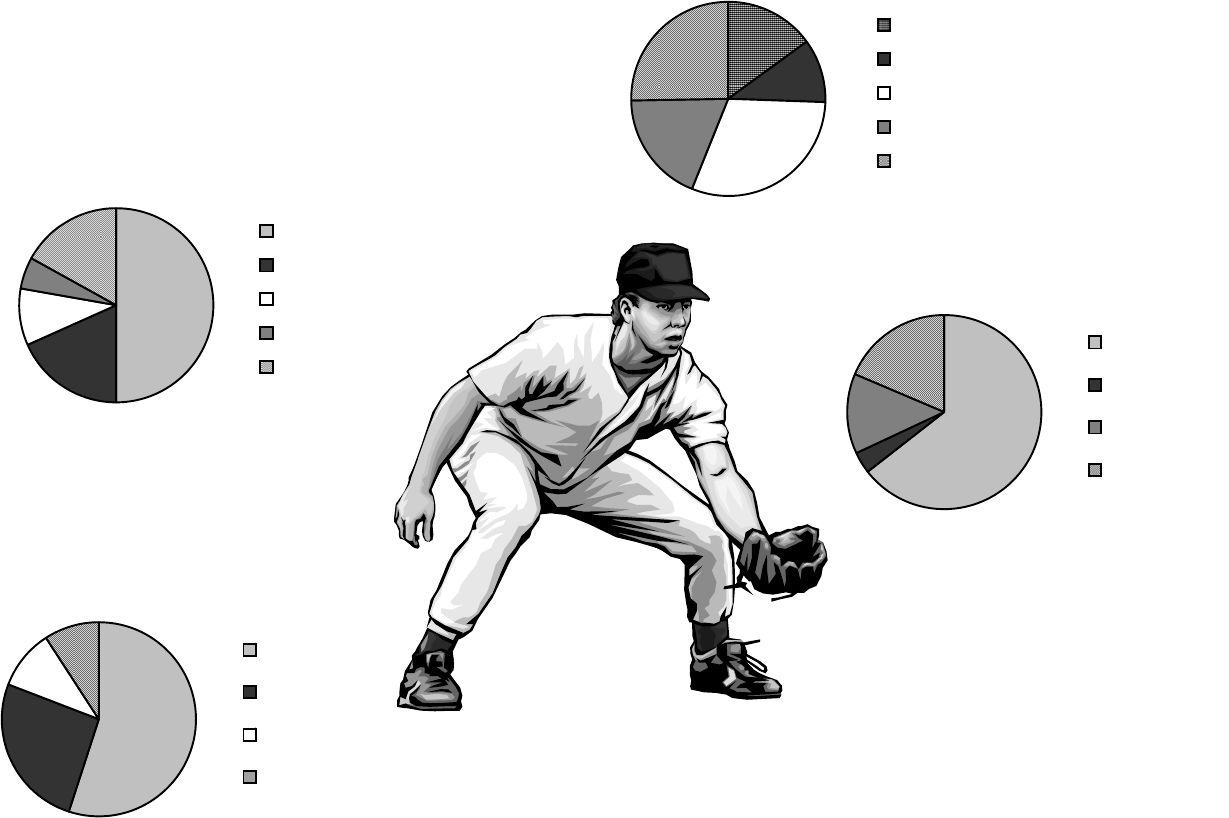
Figure 4.8 Type of Injury by Body Site for Boys’ Baseball Injuries
Head/Face/Neck
Concussion
Contusion
Fracture
Laceration
Upper Extremities
Sprain/Strain
Contusion
Other
Trunk
Sprain/Strain
Contusion
Hemorrhage
Fracture
Tendonitis
Other
Other
Lower Extremities
Sprain/Strain
Contusion
Fracture
Other
46

4.9 Girls’ Softball
The 157 reported softball injuries represent an estimated 64,563 injuries that occurred
nationally during the 2005-2006 academic year. Table 4.17 presents demographic characteristics
of injured softball athletes.
Table 4.17 Demographic Characteristics of Injured Girls’ Softball Athletes
Mean St. Dev. Minimum Maximum
Age (years)
15.9 1.1 13 19
Height (inches)
65.6 3 53 74
Weight (pounds)
138.2 24.1 97 249
n
*
†
%
Freshmen
13,769 21.3%
Sophomores
24,884 38.5%
Juniors
15,378 23.8%
Seniors
10,533 16.3%
Total
64,564 100%
* “n” represents weighted estimates representing all US girls’ softball athletes
† Cases with missing/unknown class were excluded from this table
Table 4.17 highlights:
• The mean BMI of injured girls’ softball athletes was 22.6.
• There was a higher proportion of sophomores among the injured than the other classes.
The most commonly injured softball position was the catcher (17.5%), followed by base
runners (14.6%), the pitcher (10.4%), and left field (9.5%). The most common location of injury
was home plate (24.5%), followed by second base (21.3%), outfield (13.2%), and third base
(10.9%). Table 4.18 presents mechanism by injury type.
47

48
Table 4.18 Mechanism of Girls’ Softball Injury by Type of Injury
Sprain/Strain,
n=27,180
Contusion,
n=10,295
Fracture,
n=11,094
Concussion,
n=2,695
Other,
n=13,299
Sliding
22.2% 9.4% 12.8% 0% 20.2%
Fielding
11.0% 31.4% 25.7% 14.8% 6.1%
Running bases
24.0% 10.4% 0% 5.6% 10.7%
Catching
5.4% 10.8% 34.3% 39.2% 7.9%
Throwing
10.7% 2.5% 0% 0% 26.7%
Batting
9.9% 13.4% 12.8% 9.1% 0%
Other
16.7% 22.2% 14.4% 31.2% 28.4%
Total
100% 100% 100% 100% 100%
Table 4.18 highlights:
• Sliding (17.2%) accounted for the highest proportion of injuries, followed by fielding
(16.0%).
• Concussions were caused most often by catching (39.2%) and fielding (14.8%).
Figure 4.9 presents the type of injury by body site. Figure 4.9 highlights:
• Head/face/neck injuries were composed of fractures (42.3%), contusions (23.4%), and
concussions (22.2%).
• Sprains/strains accounted for the majority of trunk (74.2%) and lower extremity injuries
(64.3%), with fewer amongst upper extremity injuries (36.9%).
• There was a greater proportion of upper extremity fractures (16.7%) than lower extremity
fractures (8.6%).
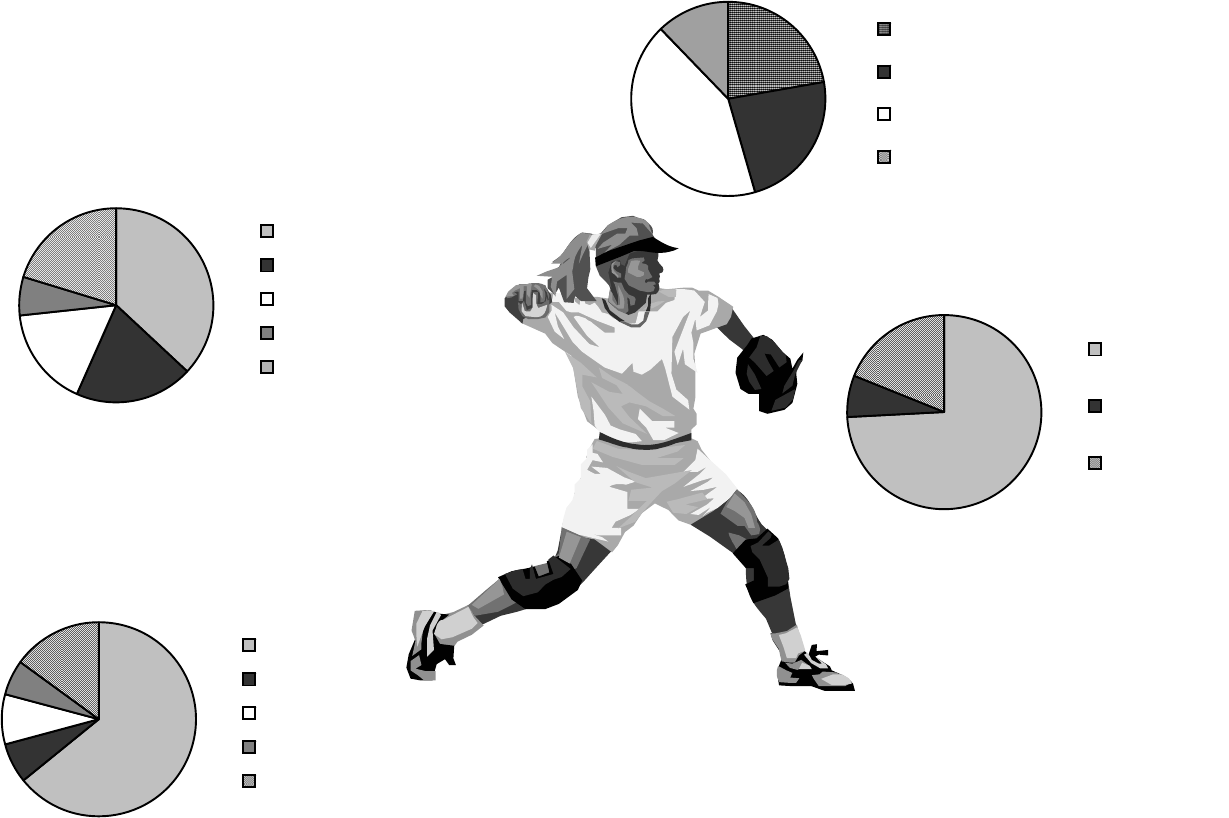
Figure 4.9 Type of Injury by Body Site for Girls’ Softball Injuries
Head/Face/Neck
Concussion
Contusion
Fracture
Upper Extremities
Sprain/Strain
Contusion
Other
Trunk
Sprain/Strain
Contusion
Fracture
Tendonitis
Other
Other
Lower Extremities
Sprain/Strain
Contusion
Fracture
Dislocation
Other
49
5. Gender Differences within Sports
5.1 Soccer
Although the overall rate of soccer injury did not differ by gender, girls’ soccer had a
higher competition injury rate than boys’ (5.2 injuries per 1,000 athlete-competitions and 4.2
injuries per 1,000 athlete-competitions, respectively) (RR=1.23, 95% CI: 1.02-1.49). Boys’ and
girls’ soccer injuries did not differ with respect to injury mechanism, time loss, and whether the
injury was new or recurring. Girls (15.2%) had an insignificantly greater proportion of
concussions than boys (9.4%) (IPR=1.61, 95% CI: 1.00-2.61). Boys had a greater proportion of
trunk injuries (11.9%) than girls (4.0%) (IPR=2.90, 95% CI: 1.47-5.75). Although girls tended
to sustain a greater proportion of lower extremity fractures (6.6%) than boys (2.4%) (IPR=2.70,
95% CI: 0.88-8.29), this difference was insignificant.
5.2 Basketball
Although the overall rate of basketball injury did not differ by gender, girls’ basketball
had a higher rate of competition injury than boys’ basketball (3.6 injuries per 1,000 athlete-
competitions and 3.0 injuries per 1,000 athlete-competitions, respectively) (RR=1.21, 95% CI:
0.99-1.48). Girls sustained an insignificantly larger proportion of injuries keeping them out of
play for >3 weeks compared with boys (20.1% and 15.2%, respectively) (IPR=1.33, 95% CI:
0.92-1.91). Girls sustained a larger proportion of concussion (11.9%) than boys (3.5%)
(IPR=3.41, 95% CI: 1.71-6.81) and a larger proportion of recurring injuries (21.2%) than boys
14.2%) (IPR=1.50, 95% CI: 1.03-2.18). Girls also had a larger proportion of knee injuries
(16.0%) than boys (9.8%) (IPR=1.62, 95% CI: 1.06-2.50). Boys (3.5%) had a larger proportion
of shoulder injuries than girls (1.2%) (IPR=2.88, 95% CI: 1.07-7.78). While 5.1% of boys’
lower extremity injuries were fractures, no girls sustained lower extremity fractures.
50
A larger proportion of boys’ injuries (50.8%) resulted from contact with another person
compared to girls’ injuries (39.0%) (IPR=1.30, 95% CI: 1.08-1.57). Boys also had more injuries
from rebounding (32.2%) than girls (18.7%) (IPR=1.72, 95% CI: 1.28-2.31), while girls had
more injuries from conditioning (11.5%) compared to boys (4.2%) (IPR=2.74, 95% CI: 1.52-
4.96). Although there were differences in mechanisms of concussions and fractures, these were
insignificant.
5.3 Baseball/Softball
Injury rates were similar between baseball (1.2 per 1,000 athlete-exposures) and softball
(1.1 per 1,000 athlete-exposures) (RR=1.05, 95% CI: 0.86-1.30). Boys’ baseball and girls’
softball injuries did not differ greatly with respect to mechanism of injury, time loss, whether the
injury was new or a recurrence, and whether the injury occurred during a competition or a
practice. Girls’ softball athletes experienced an insignificantly higher proportion of concussions
(4.2%) than boys’ baseball athletes (2.1%) (IPR=1.99, 95% CI: 0.61-6.47), while boys’ baseball
athletes experienced an insignificantly higher proportion of shoulder injuries (19.8%) than girls’
softball athletes (10.9%) (IPR=1.81, 95% CI: 0.90-3.66).
Baseball pitchers sustained a larger proportion of injuries than softball pitchers (20.4%
and 10.4%, respectively) (IPR=1.95, 95% CI: 1.01-3.75). Although baseball participants tended
to sustain a higher proportion of concussion while batting (69.5%) compared to softball
participants (9.1%) (IPR=7.6, 95% CI: 0.88-66.2), there were too few cases for this to be
significant.
51
6. Reporter Compliance
During the 2005-2006 academic year, 95 out of 100 reporters (95%) logged into High
School RIO
TM
at least once to report injury data. Of these 95 reporters, 84 (88.4%) completed a
weekly exposure report for each week of the study and completed an injury report form for every
injury reported on the weekly exposure report. There were 5 reporters (5.3%) that either missed
1 or more weeks of reporting or did not complete an injury report form for every reported injury.
There were only 2 reporters (2.1%) that were missing multiple weeks of reporting or multiple
injury report forms, and only 4 reporters (4.2%) that dropped out of the study prematurely. Of
these 6 reporters, the most common reason for failing to complete the study was being moved to
a new school.
The non-response rate of questions in the injury report form tended to be low, with most
questions having a non-response rate of less than 2%. The non-response rate was lowest for non-
sport specific questions, such as questions asking for injury diagnosis, body site, etc. It was
highest for sport-specific questions, such as questions asking for specific mechanism, field/court
location of injury, etc.
An online “End of Season” survey gave all reporters the opportunity to provide feedback
on their experiences with High School RIO
TM
. This survey was completed by 33 reporters
(33%). Average reporting times were 13.7 minutes for the weekly exposure report and 7.0
minutes for the injury report form. RIO
TM
was reported to be either very easy (84.8%) or
somewhat easy (15.2%) to use, with reporters being either very satisfied (73.3%) or somewhat
satisfied (26.7%) with the study. Suggestions provided by reporters were used to improve the
survey that will be used when the study is replicated during the 2006-2007 academic year.
52
7. Summary
High school sports play an important role in the adoption and maintenance of a physically
active lifestyle among millions of US adolescents. Too often injury prevention in this population
is overlooked as sports-related injuries are thought to be unavoidable. In reality, sports-related
injuries are largely preventable through the application of evidence-based preventive
interventions. Such preventive interventions can include educational campaigns, introduction of
new/improved protective equipment, rule changes, other policy changes, etc. The morbidity,
mortality, and disability caused by high school sports-related injuries can be reduced through the
development and implementation of effective prevention strategies as well as through improved
injury diagnosis and treatment modalities. However, surveillance of exposure based injury rates
in a nationally representative sample of high school athletes and subsequent epidemiologic
analysis of patterns of injury are needed to drive evidence-based prevention practices.
The study of high school sports-related injuries to date has largely been limited by an
inability to calculate injury rates due to a lack of exposure data (i.e., frequency of participation in
athletic activities including training, practice, and competition), an inability to compare findings
across groups (i.e., sports/activities, genders, schools, and levels of competition), or an inability
to generalize findings from small non-representative samples. The value of national injury
surveillance studies that collect injury, exposure, and risk factor data from representative samples
has been well demonstrated by the National Collegiate Athletic Association’s Injury Surveillance
System (NCAA ISS). Data collected by the NCAA ISS since 1982 has been used to develop
preventive interventions including changes in coaching habits, increased use of protective
equipment, and rule changes which have had proven success in reducing injuries among
collegiate athletes. For example, NCAA ISS data has been used to develop several interventions
53
intended to reduce the number of preseason heat-related football injuries including the
elimination of consecutive days of multiple practices, daily hour limitations, and a gradual
increase in equipment for conditioning and heat acclimation. Additionally, several committees
have considered NCAA ISS data when making recommendations including the NCAA
Committee on Competitive Safeguards and Medical Aspects of Sports’ recommendation for
mandatory eye protection in women’s lacrosse, the NCAA Men’s Ice Hockey Rules
Committee’s recommendation for stricter penalties for hitting from behind, checking into the
boards, and not wearing a mouthpiece, and the NCAA Men’s Basketball Rules Committee’s
recent discussions of widening the free-throw lane to prevent injuries related to player contact.
Unfortunately, because an equivalent injury surveillance system to collect injury and exposure
data from a nationally representative sample of high school athletes has not previously existed
the usefulness of currently available high school sports-related injury data has been limited.
During the 2005-2006 academic year, the success of the study presented here, High
School RIO
TM
(Reporting Information Online): Internet-Based Surveillance of Injuries Sustained
by US High School Athletes, demonstrated the ability to implement a national injury surveillance
system at the high school level. Dr. Comstock and her research staff are committed to using this
pilot study to launch a permanent national high school sports injury surveillance system. To this
end, The Ohio State University and the Center for Injury Research and Policy at Columbus
Children’s Hospital are funding a second year of High School RIO
TM
. Ultimately, however,
funds will need to be found to implement a permanent high school injury surveillance system.
While the health benefits of a physically active lifestyle including sports participation are
undeniable, participants are at risk of injury because a certain endemic level of injury can be
expected during any physical activity, especially those with a competitive component. However,
54
injury rates among high school athletes should be reduced to the lowest possible level without
discouraging adolescents from engaging in this important form of physical activity. This goal
can best be accomplished by monitoring injury rates and patterns of injury among high school
athletes; investigating the etiology of preventable injuries; and developing, implementing, and
evaluating evidence-based preventive interventions. Surveillance systems such as the model
used for this study are critical in achieving these goals.
55
